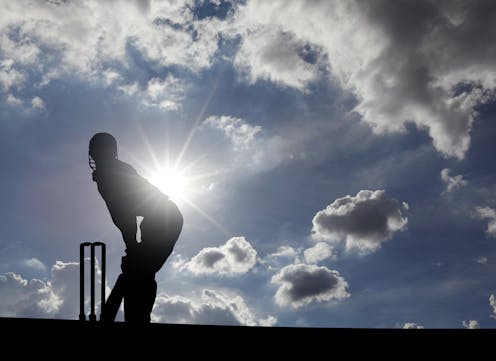Cricket Australia, fossil fuel sponsorship and climate change
- Written by Brett Hutchins, Professor of Media and Communications, Monash University

As we head towards the end of the summer sporting calendar, Cricket Australia is facing pressing questions well beyond replacing Justin Langer as coach of the men’s national teams.
Chief among them is the question of climate change. While other sporting codes[1] and teams[2] around the world are starting to use their clout to push for more[3] and faster action[4], Cricket Australia’s powerbrokers seem to be largely paying lip service to climate action. Meanwhile, many players are taking action.
You might think cricket and climate change have nothing in common. Sadly, that’s not the case. On a practical level, steadily rising temperatures and heightened natural disasters make it harder to play the sport safely over summer. And on a cultural level, fossil fuel power companies have long used sponsorships to “sportwash” their reputations[5].
It’s time for Cricket Australia to take a stronger stance on climate and turn away from fossil fuel sponsorships.
Is cricket really at risk?
There is clear and growing evidence rising temperatures, bush fire smoke, cyclones, floods and drought brought by climate change[6] are hurting cricket and the health of its players[7] around the world.
That’s to say nothing of sea level rise and stronger hurricanes[8], which threaten to take chunks out of cricket-mad island nations in the Caribbean. In June last year, Grenada Prime Minister Keith Mitchell called on[9] Cricket Australia and the International Cricket Council to sign on to UN efforts to harness sport for climate action. In response, Cricket Australia said they would look into it[10]. We’ve heard nothing further.
No doubt some readers will baulk at the idea of putting the politics of climate change and cricket together. But if the last century of sporting history has taught us anything, it’s that high level sport and politics go hand-in-hand[11], from Cold War Olympics, to race relations, to nationalism.
Climate change is the single biggest issue of our time, dubbed “code red for humanity”[12]. It’s an exceptionally well established issue seen across atmospheric, chemical and physical patterns. To tackle it requires a massive collective undertaking. That means politics. But to make big changes requires public buy-in. Sport, which absorbs so much of our attention, has a vital role to play.
Players are taking the lead on climate action
Many of Australia’s leading players – including men’s Test captain Pat Cummins – are not waiting. They are calling for urgent action to protect the sport and the generations of younger players to follow.
Read more: We need to 'climate-proof' our sports stadiums[13]
For Cummins, the realisation was personal[14]. In January 2020, his local cricket club in Penrith sweltered as Western Sydney became the hottest place on earth. Smoke haze from Black Summer megafires forced match cancellations. Two years earlier, Cummins watched as English captain Joe Root was taken to hospital after battling 47℃ heat.
Last week, Cummins launched Cricket for Climate[15], which will install solar panels on club facilities around the country. He’s not alone in his activism. This is just the latest surge of support for urgent climate action by our athletes. Cricket for Climate follows on from AFL Players for Climate Action[16], which now has 260 members. On a broader scale, there’s The Cool Down[17], a national climate campaign led by Emma and David Pocock which has more than 300 top athletes as backers, including cricket’s Alex Blackwell, Rachel Haynes and Sean Abbott.
Our athletes want faster, stronger action. So what’s the hold up?
Cricket Australia supports climate action through the fine work of the Sports Environmental Alliance[18] as an organisational member. But it could do much more.
While Cricket Australia has signed on to Cummins’ new initiative, it has not committed to either of two UN initiatives[19], Sports for Climate Action Framework or the Race to Zero Initiative.
You’d be hard pressed to find detail on Cricket Australia’s environmental initiatives. There’s no information about this in their current five year plan[20] or their annual report[21].
There’s no reporting on the “holistic” sustainability strategy[22] the organisation stated it was developing in 2020 in the face of concerns about extreme heat.
The problem of sportswashing and sponsorships
Unfortunately, professional sport is awash with lucrative sponsorships from fossil fuel companies. The main sponsor of our men’s cricket team is Alinta Energy, which owns one of Victoria’s largest coal-fired power plants, Loy Yang B[23].
While Alinta is moving into wind[24] and solar[25], its parent company, Pioneer Sail Holdings, is still the sixth highest[26] carbon emitting corporation in Australia as of 2019-2020.
These kinds of sponsorships are coming under increasing scrutiny[27] nationally and internationally, with comparisons drawn[28] between our current fossil fuel corporation sponsorships and tobacco company sponsorships in the 1980s.
Fossil fuel companies seek out the “soft power” of sport[29] as a way to improve their public image and create positive brand associations.
So what would it take to deny fossil fuel companies this kind of social license? Cricket managers don’t have to look far at all. There’s an excellent example at Rod Laver Arena, just over the train tracks from Cricket Australia’s head office.
In January, Tennis Australia sent shockwaves through sport by cancelling its multi-year sponsorship[30] with their “official natural gas partner” Santos ahead of this year’s Australian Open. The cancellation came after a long campaign targeting “sportswashing”.
Read more: Sportswashing: how mining and energy companies sponsor your favourite sports to help clean up their image[31]
This sudden shift is positive. It means the comparison with tobacco companies now has real teeth. Remember that in the 1980s, tobacco advertising was everywhere. To reduce the damage done by smoking, Australia progressively denied tobacco companies the social license offered by sponsorships and advertising, as part of a broader push. We need a similar effort to encourage a wholesale shift away from fossil fuels.
The question now for Cricket Australia is simple. How long will it hesitate at the climate crossroads, caught between the health of its players and planet and the fossil fuel interests of its sponsors? The players aren’t waiting. Pat Cummins and many other players are leading the way to a safer future for cricket and those who love it. It’s time for their national governing body to follow them.
References
- ^ sporting codes (www.world.rugby)
- ^ teams (kleinmanenergy.upenn.edu)
- ^ more (www.vfl-wolfsburg.de)
- ^ action (www.worldsurfleague.com)
- ^ “sportwash” their reputations (theconversation.com)
- ^ brought by climate change (basis.org.uk)
- ^ health of its players (basis.org.uk)
- ^ hurricanes (www.theguardian.com)
- ^ called on (www.youtube.com)
- ^ look into it (www.smh.com.au)
- ^ hand-in-hand (www.routledge.com)
- ^ “code red for humanity” (unric.org)
- ^ We need to 'climate-proof' our sports stadiums (theconversation.com)
- ^ realisation was personal (www.theguardian.com)
- ^ Cricket for Climate (cricketforclimate.org)
- ^ AFL Players for Climate Action (www.aflp4ca.org.au)
- ^ The Cool Down (www.thecooldown.com.au)
- ^ Sports Environmental Alliance (www.sportsenvironmentalliance.org)
- ^ two UN initiatives (unfccc.int)
- ^ current five year plan (www.cricketaustralia.com.au)
- ^ annual report (read.e-brochures.com.au)
- ^ “holistic” sustainability strategy (www.firstpost.com)
- ^ Loy Yang B (www.smh.com.au)
- ^ wind (www.afr.com)
- ^ solar (www.minister.industry.gov.au)
- ^ sixth highest (www.cleanenergyregulator.gov.au)
- ^ increasing scrutiny (www.theguardian.com)
- ^ comparisons drawn (www.smh.com.au)
- ^ “soft power” of sport (www.rapidtransition.org)
- ^ cancelling its multi-year sponsorship (www.theguardian.com)
- ^ Sportswashing: how mining and energy companies sponsor your favourite sports to help clean up their image (theconversation.com)

















